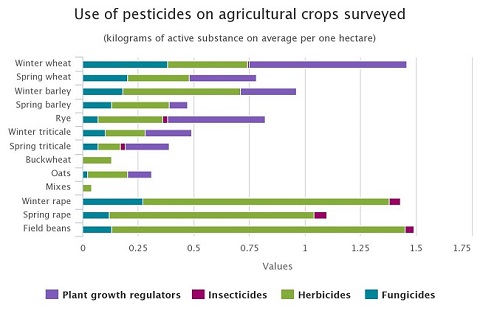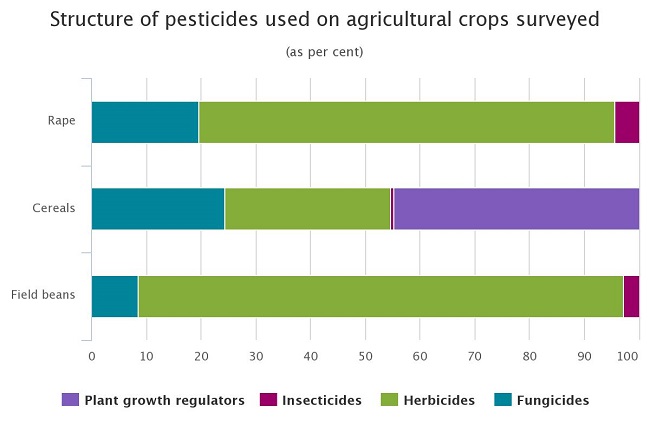Agriculture, Analytics, Good for Business, Markets and Companies, Statistics
International Internet Magazine. Baltic States news & analytics
Saturday, 20.04.2024, 02:44
Decline in volume of pesticides used on cereals and rape in Latvia
 Print version
Print versionThe survey on use of pesticides is conducted once in five years. In 2017, information for the first time was acquired also on the use of pesticides on field beans, as, compared to 2012, their sown area grew 15 times, which was encouraged by the introduction of a new support payment for climate- and environment-friendly farming practices or agricultural greening. Last year, sown areas of field beans were treated with 63.1 tonnes of pesticides or on average with 1.49 kg of pesticides per one hectare.
Use of pesticides is influenced by the structure of sown area of the respective year (pesticides on winter crops are also in autumn), climate conditions affecting the spread of diseases and insect populations, as well as by the entry of new lower weight and dose substances into the pesticide market. The areas of organic crops on which pesticides are not used have grown notably as well – by 19.8 thousand or 65% in 2017, compared to 2012.
Almost just like five years ago, wheat are the cereals treated with the pesticides the most commonly – 1.45 kg per one hectare of sown area (1.51 kg in 2010), followed by winter barley – 0.96 kg (1.41 kg in 2012), and rye – 0.82 kg (0.64 kg in 2012). Areas of winter rape were treated with 1.43 kg of pesticides (1.75 kg in 2012). Pesticide use on one hectare of oats, buckwheat or mixed cereals was notably lower.

Herbicides were the most common type of pesticides used on one hectare of sown area, moreover the most often they were used on winter rape (1.11 kg in 2017), spring rape (0.92 kg), winter barley (0.53 kg), and field bean (1.32 kg) areas. Plant growth regulators more often are used on winter wheat areas – 0.71 kg on one hectare of sown area, while insecticides which are destined for pest control are used very little, as the dose thereof per hectare is very small and the level of pest intensity during the crop yield was low.
In 2017, the share of herbicides used on cereals in the total volume of pesticides used constituted 30.3% (41.8% in 2012), that used on rape took 78.8% (77.4% in 2012), and that used on field beans 88.6%. The volume of insecticides used on cereals in the total volume of pesticides used comprised only 0.5% (4.1% in 2012), while in that used on rape areas – 3.8% (3.6% in 2012).

Cereal, rape and field bean areas were treated with 100 various active substances, while only 15 of them took 75% of the total weight of pesticides used. The plant growth regulator chlormequat chloride accounted for 31.4% of the total volume of active substances used on the surveyed crops, the weed killing substance glyphosate took 12.1%, while 55.3% of the total weight of pesticides used on field beans were taken by the weed killing substance aclonifen.
The first survey on use of pesticides on cereals and rape was conducted in 2012. The data acquired may be used to assess possible risks caused by the pesticides to environment and human health. Results of the first pesticides survey conducted by the CSB were published in the press release of 16 October 2013 (Pesticide use per 1 ha of sown area: 1.04 kg on cereals and 1.54 kg on rape).








 «The Baltic Course» Is Sold and Stays in Business!
«The Baltic Course» Is Sold and Stays in Business!

